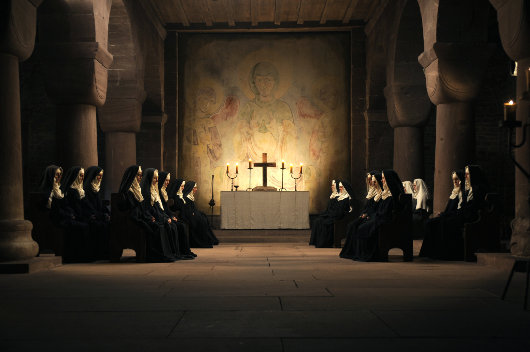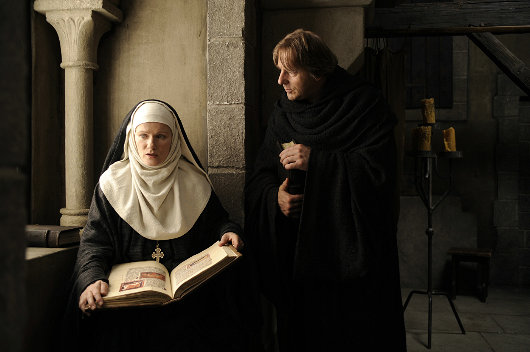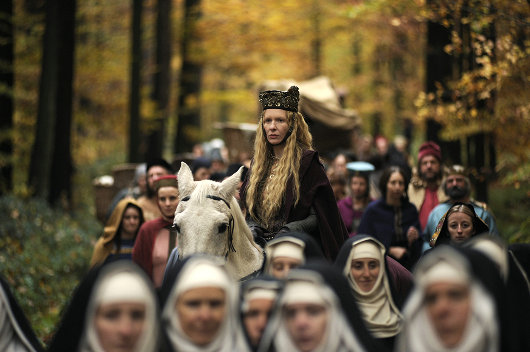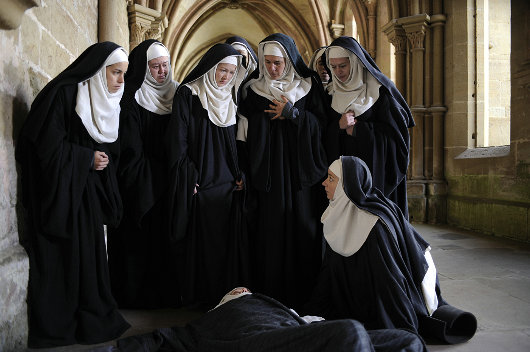
About Andrew Cusack
 Writer, web designer, etc.; born in New York; educated in Argentina, Scotland, and South Africa; now based in London.
Writer, web designer, etc.; born in New York; educated in Argentina, Scotland, and South Africa; now based in London. read more
News
Blogs
Reviews & Periodicals
Arts & Design
World
France
Mitteleuropa
Knickerbockers
Argentina
The Levant
Africa
Cape of Good Hope
Netherlands
Scandinavia
Québec
India
Muscovy
Germany
Academica
Life of St. Hildegard Hits the Silver Screen
But is it the Hildegard of historical fact or modern fantasy?

THE LIFE OF Saint Hildegard von Bingen — the Benedictine nun, writer, scientist, physician, and poet perhaps best known as a composer — has been brought to the screen in a new German-produced film. “Vision – Aus dem Leben der Hildegard von Bingen” was released in Germany & Austria in September and may receive a wider European release in 2010. From the voluntary confinement of the cloister, this woman corresponded with the Emperors Lothair II and Frederick Barbarossa, the popes Eugene III and Anastasius IV, the great patron of art Abbot Suger, and of course the great Cistercian reformer St. Bernard of Clairvaux. Hildegard was authorised to go on four preaching tours, and her Ordo Virtutum was the first allegorical morality play of the medieval period. She even invented a demi-language, Lingua Ignota (“unknown language”), and created an alternative alphabet in which to write it.

In recent decades, interest in Hildegard has grown, often as a result of the popular rediscovery of her beautiful and often haunting music. But the image of the saintly polymath, faithful her whole life to the teachings of the Church, has also been manipulated by radical elements such as feminist academics and New Age believers. The reality of this brilliant and talented woman is in such marked contrast to the unhistorical modern stereotype of medieval women as enslaved, oppressed, uneducated, and ignored that modernist radicals have tried to claim St. Hildegard as a proto-feminist and rebel. Nothing, however, could be further from the truth, as her writings contain explicit condemnations of every kind of immorality popular today, while extolling the benefits of the Christian spiritual life and virtues.

I haven’t had the opportunity of seeing this film yet — it has neither been released on these shores yet nor is it available on dvd — but a number of aspects of the production do not bode well. The director is the radical German feminist Margarethe von Trotta, responsible for the hagiographical 1986 Rosa Luxemburg about the violent Communist revolutionary of that name. Von Trotta’s most recent film to receive an art-house distribution in English-speaking countries was Rosenstrasse in 2003.

The film’s trailer begins with depictions of severe self-flagellation, the extreme form of mortification which has been officially condemned by the Catholic Church for centuries. The Flagellant heresy was never particularly widespread but reached its zenith during the years of the Bubonic Plague. While long condemned, pockets of flagellation continue to exist in Spain, Italy, New Mexico, and the Philippines — a particular indictment of the negligence of local bishops, the rebelliousness of local laymen, or both. Why flagellation features at all in a film of this great saint is beyond reason, unless perhaps the director seeks to portray Hildegard as brilliant in contrast to the Church rather than as brilliant in rhythm with the Church. In which case, the deceiver manages to doubly fool his or her audience with erroneous notions both about a great saint and about the God whose Church she dedicated her entire life to.

German film and theater actress Barbara Sukowa plays the title role, while Heino Ferch — who played Albert Speer in the superb last-days-of-Hitler film “Das Untergang” (released in Angledom as “Downfall”) — is her secretary, the monk Volmar. In addition to those from “Downfall”, actors and actresses in von Trotta’s “Vision” include the alumni of a number of German films to gain releases in Britain & America, including “The Counterfeiters”, “The Baader-Meinhof Complex”, and “Sophie Scholl: The Final Days”.
It is rare for proper cinematic productions to be made depicting the lives of Catholic saints. The actor Sergio Castellitto’s depiction of Padre Pio in the 2000 Italian television production is the most recent I can think of, and is an absolute must-see for anyone with a DVD player (a Region-1 disc is available from Ignatius Press). Given the director’s unsympathetic background, it’s hard not to hold much lower hopes for von Trotta’s film, but we ought to give it at least the benefit of a view should it ever reach the cinemas here.
Search
Instagram: @andcusack
Click here for my Instagram photos.Most Recent Posts
- Christ Church December 29, 2024
- A Christmas Gift from the Governor December 24, 2024
- Oude Kerk, Amsterdam December 24, 2024
- Gellner’s Prague December 19, 2024
- Monsieur Bayrou December 18, 2024
Most Recent Comments
Book Wishlist
Monthly Archives
Categories



Self-flagellation is still a form of corporal mortification used in the Church, and had never been condemned, whereas “public” flagellants have. Mr. Donald Attwater’s 1958 “A Catholic Dictionary” gives the following definition for the “discipline”:
“A small whip or scourge of cords variously arranged, used for self-inflicted mortification. Its use is prescribed in the more austere religious orders and congregations; among the Cistercians, for example, it is self-administered on most Fridays of the year after the night-office for the space of a Miserere. Its voluntary use should be submitted to the advice of a prudent director.”
Using the discipline is just one form of corporal mortification. Other forms include wearing a hair shirt (Pope Paul VI did this), wearing the cilice (a modern form of the hair shirt which was worn by St. Josemaria for one), and of course, fasting. St. “Padre” Pio and Blessed Theresa of Calcutta also used the discipline. Sadly, many modern novels and films have given corporal mortification a bad name (The DaVinci Code, etc.)
I think there is a big difference between moderate acts of self-mortification, as are normal for many Catholics, and the extreme forms of self-flagellation which produce physical harm and draw blood. The latter are surely a sin defiling the body as a temple of the Holy Spirit.
Cusack seems to be talking of Flagellants proper, not self-mortification.
Apparently the slightest controversial aside quickly devolves into something wholly other than what was intended, rather than a civil (and hopefully critical)discussion concerning the merits of the film; I will abstain from any more musings on the legitimacy of flagellation. It is not a question of the essence. I must admit that if the stills are any indication then it might be admitted that should the film be anything less than orthodox, at the very least it will be a couple of hours of eye candy.
You are right, Andrew, cinematic productions about the lives of Catholic saints are pretty rare.
A good one (I think) is France’s “Monsieur Vincent” from 1947. I’m also very fond of Rossellini’s “The Flowers of Saint Francis” as well. “Into Great Silence”, a documentary about the Grande Chartreuse in the Alps, is stunning.
But the trailer for “Vision” makes it look like an overblown Hollywood production with feminist overtones.
O.O I found this site totally by accident, as I am in the process of writing a short thesis on Hildegard, and I want to see this movie SO MUCH.
I would like to point out as a general and mild disagreement that Hildegard is very much a proto-feminist, and that feminism is not synonymous with immoral behavior of any type. Hildegard’s feminism is that which extols the virtues of women even while understanding the role and place of women in God’s plan. Just something for you to think about; most feminists aren’t what you are apparently thinking of.
Is this movie available in English?
KD- since I like all the movies on your list you might enjoy the Italian teleivision mini-series on Don Bosco which can be rented on DVD but play it in Italian with English sub-titles!
Knowing the ‘feminist’ director of THIS film, I wouldn’t go near it without blood pressure medicine.
i was surfing for videos made for saint hildegard when i accidentally found this site.actually i am looking for this kind of movie for st. hildegard’s feast day this sept. 17..where can i get it and can i have an english translation,pleaseee..=)
i’ve seen the trailer and i really wanna watch the movie, hope to screen it in my country.
i just saw the film in santa fe
true that at the time….mentioned in the film that the middle east was more advanced in medicine.
Hildegard…….. extraordinary human that had much courage and true grit for her time or any tine,
I watched the film with an Austrian born friend and he commented on what a wonderful job they did with the language and the Latin for the time period….that is in the film……felt it was a good experience to read the sub titles and let the language be a part of the sound experience
does anyone know where this was filmed? i love the architecture of the medieval cloisters and would like to visit this place. please advise if you know. thanks.
This film is now available on Netflix via streaming and DVD here in the US. I have yet to watch it.